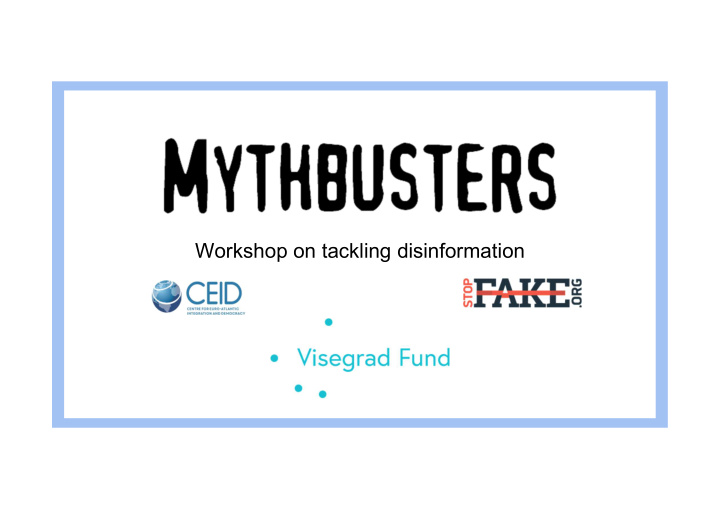



Workshop on tackling disinformation
Who we are
Overview Hungarian specificity Central Europe Situation on the frontlines: Ukraine A kép nem jeleníthető meg.
15 minutes to check: What should you do?
Main attributions: 1. Headline vs content 2. Authors/ Editorial board/ Ownership 3. Source/ Experts 4. Images/ Videos 5. Advertisements 6. Social pages/ Comments 7. Readership statistics
Headline vs Content
Headline vs Content What to check: Does the title have anything to do with the rest of the article? Does the title play with emotions? What is the date of the article? Is the original source translated correctly?
Authors/ Editorial board/ Ownership Questions to ask: Is she/he independent or for what media outlet has she/he worked for before? Who is the author of the article? What do we know about the website (is there Is it her/his real name or a nickname? any contact information, address)? Is it “admin” or a real person who has a track Is there an “About/Contact” page? record of other publications? Who owns the publication and where is it Check them on Twitter/LinkedIn/Google/Fb registered? What other articles did she/he authored? Were Is there anybody politically biased sitting in the they biased/unbiased? editorial board?
Authors/ Editorial board/ Ownership
Authors/ Editorial board/ Ownership Tool
Authors/ Editorial board/ Ownership Tool
Source/Experts Questions to ask: Google the quotation used. What is the website url/domain name? Check if the source is in the EUvsDisinfo database. Is the website legitimate or is it trying to imitate a popular news site or organisation? Wikipedia – check the modifications Double check spelling, what it links to and if the website/media outlet/piece it links to exist. If the source referred to in the article is a person do the same as with the authors.
Wikipedia edits
https://euvsdisinfo.eu/disinformation-cases/
Check the source “Poroshenko turned out to be sick”
Check the source
Double check
Fake experts:
Images/ Videos Questions to ask: Was the image related to the article/problem? (Use Google Reverse Image Search) When and where was the image taken? Is there any reference on the image? (Check the source) Pay attention to details in the picture. Do they correspond with the context (place, language etc).
Images/ Videos Can you check this?
Images/ Videos
Tools: Reverse image search on Google TinEye.com FindEXIF.com Fotoforensics.com Prepostseo.com ImgOps
Fake videos...
Video manipulations
Channel 1: “Ukrainians are forced to flee to Russia due to the political instability”
Look for signs
Look for signs
Working with video fakes Work with screenshots Use search (YouTube, Vk, date, length) Look for signs (place, date, time)
Search Mother calling upon “junta” for killing her son = Mother calling upon Putin for killing her son https://www.youtube.com/watch?v=pjl129Sj8j8
Advertisement Advertisement is often used to legitimize content. Questions to ask: Is there any real advertiser on the website? What is the profile/origin of the advertiser? Do they have real interest to advertise on this page?
Social pages/ Comments Questions to ask: Where are they present? Are there Vk/Odnoklassniki buttons on the website? How many followers do they have? What is the language of the comments?
Social buttons
Share buttons
Readership statistics Questions to ask: How to check: What is the main audience of the website? Alexa.com What is the size of the audience? Similarweb.com Are these real people or referral traffic? (bots)
Questions? Thank you!
Recommend
More recommend